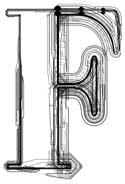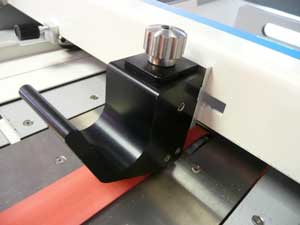Mention ‘friction feeder’ to someone with bindery experience and you just might see them curl their lip in disgust. It’s in the same category as ‘static’, something to be avoided. But like static, friction has its uses and benefits when understood and applied correctly, especially with regard to friction feeders.
 When I was brand new to folding machines, I was introduced to an old Bell & Howell friction feed Baumfolder. Even though I had good training from the mechanic who had just refurbished it, I grew to dislike the ‘green machine.’ I preferred to use an even older Baum because it was air-fed and generally easier to run the coated text weight stocks that came through our bindery. So it was that the green machine entered a rather unceremonious chapter of its life, being used as my coffee table or as a work bench for visiting mechanics.
When I was brand new to folding machines, I was introduced to an old Bell & Howell friction feed Baumfolder. Even though I had good training from the mechanic who had just refurbished it, I grew to dislike the ‘green machine.’ I preferred to use an even older Baum because it was air-fed and generally easier to run the coated text weight stocks that came through our bindery. So it was that the green machine entered a rather unceremonious chapter of its life, being used as my coffee table or as a work bench for visiting mechanics.
Then one day I encountered a job that was too small to run on my favorite folder but just right for the little green machine. Necessity (and my boss) forced me to clean off the muck and coffee stains for a self-taught crash course in setting up and running a friction feeder.
To my surprise, I got that tiny coated job to fold fast, accurately, without scratches or scuffs, and in a fraction of the time it would have taken on the older pile-fed machine. Since this was a high-volume repeat job, the green beast became my go-to machine for that job every month and for similar jobs for years to come.
Friction had become my friend and ally. When you look around the printing industry and the world at large you see that friction feeders are everywhere; in copy machines, laser and inkjet printers, collators, folding machines, inserters, folder gluers, packaging machinery, and more.
There are compelling reasons for this:
- They are relatively low cost. No pumps or sophisticated electronic controls are necessarily needed.
- They can feed bulky or oddly shaped materials that often can’t be air fed.
- They can operate at extremely high speed for extended periods. Folder gluers in the packaging industry can routinely run at 50,000 to 100,000 pieces an hour.
- They are relatively simple to set up and operate…once you understand them.
So let’s try to understand them. Bindery equipment is all about physics, or the forces acting on the sheet of paper, the signature, or the book. In a friction fed machine, our intent is to apply forces in such a way that the sheet moves correctly and consistently from the feeder to the delivery or to the next station.
Friction feeding is based on the principle that different materials have different friction holding them in place (in addition to gravity.) Think of Static Friction as the amount of force required to START an object moving. Think of Kinetic Friction as the amount of force required to KEEP it moving. The measure of those friction forces is called the coefficient of friction.
Before your eyes glaze over, let’s see how this applies to paper in our friction feeder. The friction of paper against paper is very low. Put another way, paper slides easily over paper. According to Tappi.org, typical business papers have a coefficient of friction in the range of .31-.59. The coefficient of static friction for rubber against paper is much higher at 1.3-1.4. Paper does not slide easily over rubber. That's why in a copier for instance, when a rubber roller or feed belt hits the top sheet, it easily breaks the static friction between the top two sheets. The trick then is to apply just enough force to get the top sheet moving. (Too much force and you’ll get double or more sheets.)
The concept is simple. The reality is a little more complicated because there are other forces at work in all friction fed machines. You might run into skewed sheets, double sheets, no sheets, or scuffed sheets. Here are a few items to remember when troubleshooting your friction feeder problem.
The paper should always be centered on the drive point of the feeder. If it’s off center it can twist as it exits the feeder. A bowed score or perf line from the lead edge to the tail edge is an indication it’s happening in the feeder. A little ‘tailing’ at the back of the sheet indicates it’s probably happening in the accessory or pull-out shafts. If your feeder has a register table attached, you can get away with a bit of sloppiness since the register table will square up the sheet before it hits the next section.
 Avoid excess stock. There are two basic types of friction feeders. One style feeds from the bottom; the other from the top. The Baum I mentioned feeds from the top. Our CreaseStream Mini AutoFeed (photo at right) feeds from the bottom. The bottom-fed machines are easier to run continuously because you simply load paper on top of the pile. However, if you load too much paper, you’ll get either double-fed sheets or no sheets at all. That’s because additional paper applies additional force, making it easier to pull two sheets.
Avoid excess stock. There are two basic types of friction feeders. One style feeds from the bottom; the other from the top. The Baum I mentioned feeds from the top. Our CreaseStream Mini AutoFeed (photo at right) feeds from the bottom. The bottom-fed machines are easier to run continuously because you simply load paper on top of the pile. However, if you load too much paper, you’ll get either double-fed sheets or no sheets at all. That’s because additional paper applies additional force, making it easier to pull two sheets.
Top fed machines are a little trickier to run continuously. For best feeding results you want to keep your fanned pile about the same as the machine runs; that’s why it takes practice. You have to carefully lift the pile, slide the right amount of new sheets underneath, and gently lay the entire fanned pile back down on the table. Rough handling or lifting the pile too high will cause doubles or mis-feeds because, you guessed it, too much force is applied to the underlying sheet. With both types of feeders you often find that the last few sheets in the stack may not run through because the force between paper and rubber has changed.
The angle of the infeed table will affect feeder performance. If your table is adjustable and you are having problems, you might want to experiment with different angles.
Infeed guides will affect the sheet. If they’re too tight or too loose it won’t feed properly. They should be set so that the sheet can move freely up and down the table without any twisting movement. This is especially important on the direct infeed machines.
The paper itself can be the problem. Paper has two sides, each with a different coefficient of friction. Inks, toners, varnishes and coatings will change the performance of the paper. The paper could be contaminated with paper dust from sheeting or cutting, or from press spray powder. Any of these can change throughout the run. Try flipping or rotating the sheet if you encounter a problem. I found that carefully applying a small amount of glycerin to the feed roller would often overcome spray powder or dust problems or problems with especially slick stocks.
Paper can scuff or scratch. This is what gives friction feeders a bad name. Matte and dull coated stocks are especially sensitive to scuffing when rubbed. Yet friction feeders will handle a remarkable range of gloss coated stocks without any issues and uncoated stocks shouldn’t be a problem. A common problem with uncoated stocks is that inks or toners that don’t set or dry correctly and they offset on the sheet below. Rotating or flipping the sheet can help in these cases.
Feed rollers or belts can stop working. They need to be kept clean and free of dust. Over time they can become glazed with a buildup of paper dust, inks and coatings. This reduces their friction and effectiveness. These must be cleaned using only the manufacturer’s recommended solvent! The wrong solvent can adversely affect the properties of the rubber as much as the glaze.
Retard rollers or strips will wear out. These are the components that when set properly, allow just a single sheet to pass through the feeder. Flat spots will gradually appear on rubber retard rollers and usually these can be rotated to a fresh round spot. Retard strips will lose their finish and need to be replaced.
My little green machine saved me on many occasions. Don’t let a friction feeder’s limitations, or worse yet its perceived limitations, disqualify it for all those other jobs it CAN effectively handle.
As always, if you liked the article be sure to share it using the social buttons. Comments and suggestions are welcome too.


